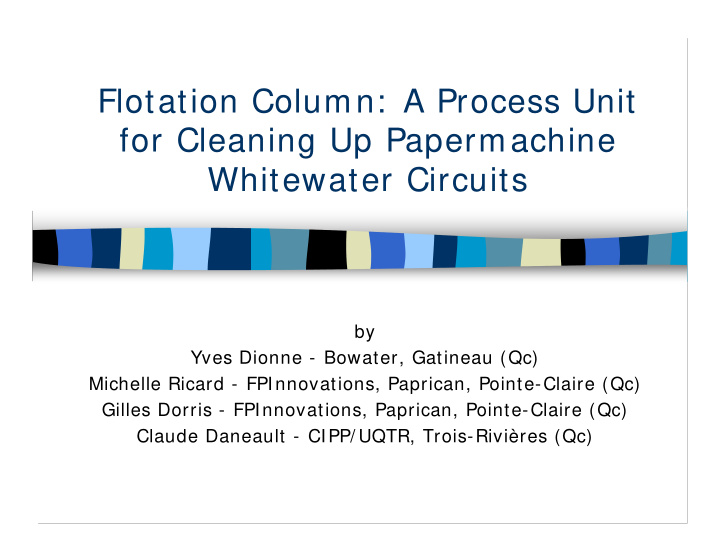



Flotation Column: A Process Unit for Cleaning Up Papermachine Whitewater Circuits by Yves Dionne - Bowater, Gatineau (Qc) Michelle Ricard - FPInnovations, Paprican, Pointe-Claire (Qc) Gilles Dorris - FPInnovations, Paprican, Pointe-Claire (Qc) Claude Daneault - CIPP/ UQTR, Trois-Rivières (Qc)
W hitew ater Circuit Source: Bonin, J. ( 1 9 8 8 )
Problem atic � Loss of brightness on the paper machine which amplifies during Summer � Generates loss of production time, higher rejects rate, higher freshwater consumption, loss of quality, increase of bleaching cost, delays in delivering paper to our customers, insatisfaction of customers and higher level of stress to the employees. � This brightness loss is estimated at 1.365M $Cnd.
Paper Machine No 6 � Beloit Bel-Form � Installed in 1967 � Rebuilt in 1993 � 9,1 m width � 980 m/ min � 180,000 ADMT/ y
Brightness Loss PM6
Problem Analysis � After many cycles of recirculation, fines lose brightness, are tainted by repeated dye applications, and are contaminated in extractives, micro- stickies and metals.
Solution Improve fines management by incorporating a treatment process: Cleaning? Retaining? Flushing?
Proposed solution � Installation of a flotation column at the wire pit in order to clean up the papermachine whitewater circuits.
Flotation colum n � Technology from the mining industry � Limited success in the P&P industry (Kvaerner Hymac Inc - 11 installations around the world in 2006) � Always aimed to replace conventional flotation technology
Flotation colum n W ASH W ATER Froth Zone REJECTS Collection Zone FEED ACCEPTS AIR
Our goals � Higher fines brightness in the wire pit = brighter paper � Fines less sticky = Cleaner Paper Machine = Higher runnability � Lower fresh water consumption = Lower fibre loss to sewer � Reduction in overall chemicals
PRELI MI NARY TRI ALS Conventional lab flotation unit PM6 Feed Accepts- Rejects – Accepts – Rejects – No No 0.05 % 0,05 % chemistry chemistry surfactant surfactant Consistency 0.381 N.D. N.D. N.D. N.D. (%/o.d.) Brightness 53.87 57.08 41.37 58.28 40.91 (ISO) L 79.26 81.38 70.47 82.37 69.9 a* 1.26 1.12 1.95 0.69 1.97 b* 2.07 2.58 0.40 3.28 0.22 ERIC value 264.8 172.6 904.5 117.4 930.0 Ash (%) 17.6 N.D. N.D. N.D. 35.2 N.D. Not determined
Flotation colum n diam etre 1 0 ,2 cm height 4 ,6 5 m
Characteristics - PM w hitew ater silo Table I. Characteristics of mill whitewater sam ples. Type of whitewater Silo M ill Product Newsprint DIP, % 50 TM P, % 50 Consistency, % 0.53 Ash Content, % 15.2 ISO Brightness a , % 56.1 a , ppm ERIC 195 Extractives a , % DCM 2.1 a M easured on handsheet of fines
I m pact on extractive 6 m aterials Flotation Time, min 3 0 2.5 2.0 1.5 1.0 0.5 0.0 DCM Extracts , % (w/w)
6 I m pact on ink Flotation Time, min rem oval 3 0 250 200 150 100 50 0 ERIC, ppm
I m pact on brightness 6 Flotation Time, min 3 0 59 58 57 56 55 54 Brightness, %
Brightness gain + 1 .8 % Feed Accepts Rejects 5 6 ,1 % 5 7 ,9 % 4 1 ,2 %
1000 Changes in particle size 100 Particle Diameter, µm 10 Acce pt Reje ct Fee d 1 0.1 6 4 2 0 Frequency, % of Volume
Evolution of m ean 6 Rejects 5 particle size Flotation Time, min 4 3 2 Accepts 1 0 30 20 10 0 Mean Particle Diameter, µm
Conclusion ( 1 ) � Total extractives reduction up to 85 % � Ink removal up to 64 % � Brightness lift of 1.8 points � Column flotation removes selectively the smallest fines/ filler that are the most hydrophobic � Longer flotation time increases performance but also increases material loss
Conclusion ( 2 ) Selective removal of lipophilic material leads to a cleaner paper machine whitewater circuit with potentially improved optical and strength properties of paper.
Acknow ledgem ent � Management, BOWATER Gatineau � FPInnovations, PAPRICAN � Christine Lapointe � Nathalie Pagé � Yuxia Ben � EKA Chemicals
Recommend
More recommend